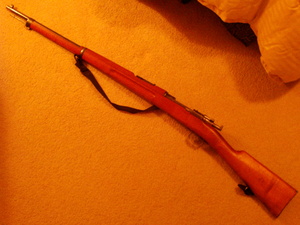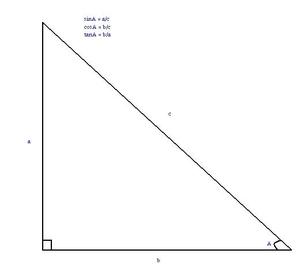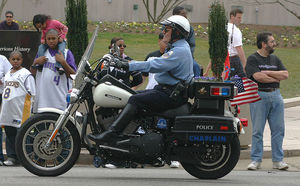The Model 96 Swedish Mauser is a bolt-action battle rifle that fires 6.5x55mm ammunition. It has a sturdy wooden stock and a 5-round internal box magazine that can be loaded from the top via stripper clips. As a battle rifle originally designed for trench warfare, the M96 Swedish Mauser is sighted in for 300-meters. However, contemporary shooters can order different front sight blades to adjust the range. The rifle also has an innovative ladder style rear sight that can be adjusted for longer ranges or flipped up for volley fire. A Model 96 Swedish Mauser weighs in at 8 pounds 13 ounces and is 49.6 inches long. Compared to many battle rifles of the 20th century, the Swedish Mauser has strong purposeful lines and an understated elegance.
The Swedish Mauser has an interesting service history. In the late 19th and early 20th century, rifles designed by Paul Mauser were popular with armies around the world. The Sweden selected the 1896 Mauser as their light infantry rifle. They specified that it would use 6.5 x 55mm developed by the Swedish-Norwegian kingdom. At the time, the use of such a high-velocity small caliber bullet was an innovation. Today, modern Armies use 5.56mm or 7.62mm cartridges.
The Swedes also specified that their Mauser would differ from most 1896 Mausers by cocking when the bolt was closed rather then when the bolt was open. The Model 1896 Swedish Mauser served the Swedish Army from 1896 until 1995 (when the remaining Sniper rifle variants were officially retired). In 1938, the Swedes stopped producing the Model 96 and adopted the shorter Model 38 Carbine. The M38 Carbine is based on the same Mauser action, but is 7-inches shorter and a little easier for soldiers to handle in suburban warfare. If you ever travel in Northern Sweden, you’ll see long trains filled with iron ore. The Swedes were proud of their steel and mandated that it be used to make all of their rifles.
When you examine a Swedish Mauser, there are a few interesting things to note. First, on the right side of the rifle butt, you’ll usually find a mysteriously marked brass disk. The disk was used to note the condition of the bore and how much “hold over” was needed when firing a lighter and faster version of the 6.5x55mm cartridge that was introduced in 1941. As you examine the area around the bolt, you’ll see a Swedish crown, the year of manufacture, and the name of the factory that produced the rifle. For example, the Swedish Mauser shown in this article was made in 1916 at Carl Gustav’s City Rifle Factory
(Carl Gustafs Stads Gevarsfaktoriet). You will also see small Swedish crowns and the serial number of the rifle on various metal parts of the Swedish Mauser. The Swedish Army used a blank adapter that was threaded onto the end of the barrel. Thus, many Swedish Mausers have threads at the end of the barrel. Collectors will also be interested to know that a nice bayonet is available for the Swedish Mauser. The bayonet is made of high quality steel and is a nicely proportioned fighting knife.
The 6.5mm Swedish Mauser is a very accurate surplus rifle. All were well made and are free of the shortcuts that are seen in rifles made by the desperate powers locked in the epic struggles of World War I and World War II. Due to the 300-meter sights, the Swedish Mauser will shoot nice groups, but will shoot high at a typical 100-yard range. A shooter should aim low on the target paper or get a taller front sight blade to move the shots into the bulls eye. Due to the weight of the rifle and the size of the cartridge, recoil from a Swedish Mauser is relatively mild for a battle rifle.
Over the years, I have found my Swedish Mauser fun to shoot and a very solid rifle. It’s been difficult for me to really get the best accuracy with my Swedish Mauser on typical 100-yard suburban shooting ranges. However, when I am consistent in taking my shots and picking an aim point, I get good groups with the rifle. 6.5x55mm ammunition for Swedish Mausers is expensive compared to more common cartridges. But, the Swedish Mauser is fun to shoot due to a magnificent bolt action, precise sights, and a very smooth trigger pull. Due to a crack in the butt that had been professionally repaired by Swedish Armourers, my Swedish Mauser sold for about $75 in the late 80s or early 90s. Today, Swedish Mausers have appreciated considerably and surplus Russian Moisin-Nagant bolt-action rifles are the gunshow bargains. Overall, the Swedish Mauser is a great addition to any battle rifle collection. It might just be the best battle rifle of the twentieth century because it never had to fight.
Sources:
“6.5X55mm,” Wikipedia, http://en.wikipedia.org/wiki/6.5x55mm
“Swedish Mauser,” Wikipedia, http://en.wikipedia.org/wiki/Swedish_Mauser
“The Ballet Dancer,” SurplusRifles.com, http://www.surplusrifle.com/shooting/swede/index.asp
Steve Kehaya and Joe Porter, “The Swedish Mauser,” Northcape Publications, http://www.northcapepubs.com/swmauser.htm
Chuck Hawks, “The 1896 Swedish Mauser,”http://www.chuckhawks.com/swedish_mauser.htm




